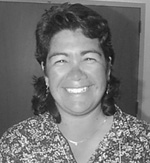Show and Tell - How DO-IT Does It

DO-IT Show and Tell is an exciting disability awareness program for Seattle and Spokane School District first grade students. It expands on the practices of traditional show and tell activities and also offers a valuable work experience to the college students who are blind who serve as presenters. The project helps children develop positive attitudes and perceptions of people with disabilities, develop problem-solving skills, and experience how people with disabilities use computers and perform day-to-day tasks. The quotations included in this article are taken from thank you notes sent by the students to DO-IT Show and Tell presenters, following their visits.
DO-IT Show and Tell presentations include a combination of question/answer opportunities, story-time, Braille writing demonstration, and a cane mobility activity. After an initial discussion about blindness, students may be asked to problem solve a variety of situations described by the presenter: How do you think I picked out the clothes I am wearing? How do you think I traveled here today? How can I do my grocery shopping? How can I use my computer? There are also questions the students are anxious to ask: How do you know when to wake up in the morning? Does it hurt to be blind? How can you watch TV? How do you know that the bathtub is full? Presenters use these inquiries to describe a life that is active and accomplished despite the presence of their disability.
"I never thought I could learn so much about blind people."
"I learned blind people can get jobs."
"I learned that you can live by yourself."
First grade students spend a great amount of time developing reading and writing skills, so reading and writing Braille is viewed with admiration and wonder. Classroom teachers provide a list of the students' names, so the presenter can arrive with each child's name Brailled onto an index card. Waiting to be called forward to receive a card with his name represented by the mysterious dots is an exciting time for each participant!
"I really liked how you explained Braille."
"Thank you for coming in our class and sharing Braille."
"I like you. I like how the machine works. I think you are cool."
"Thank you for the card with our names on them. When I took it home my mom was happy."
"Miss Nelson is Missing" and the "Cat in the Hat" are two story options used in a demonstration of reading by Braille. One presenter has also used the oral tradition of storytelling to show how much she relies on her memory, and challenges the students to use their imagination to picture the scenes of the poem that she weaves with words. Many visits wrap up with a chance for the students to try maneuvering through the maze of desks in their classroom with a child-size cane. The students take the challenge quite seriously; eyes are squeezed tightly shut as they carefully swing the cane back and forth in front of them.
"I learned that some people have a guide dog and some have a walking stick."
"Being able to use the cane was fun!"
DO-IT Show and Tell offers a tremendous experience for the first grade students to expand their understanding of the challenges and abilities of people with disabilities. In addition, it helps Show and Tell presenters develop skills in public speaking, teaching, and managing a classroom. They also experience the admiration of their young audience!
"I'll bet you'll be a famous blind person."
"Do you want to be my friend?"
"I am proud of you. Will you come back?"
"I wish you were my teacher."
"I like you and nobody is going to stop me!"